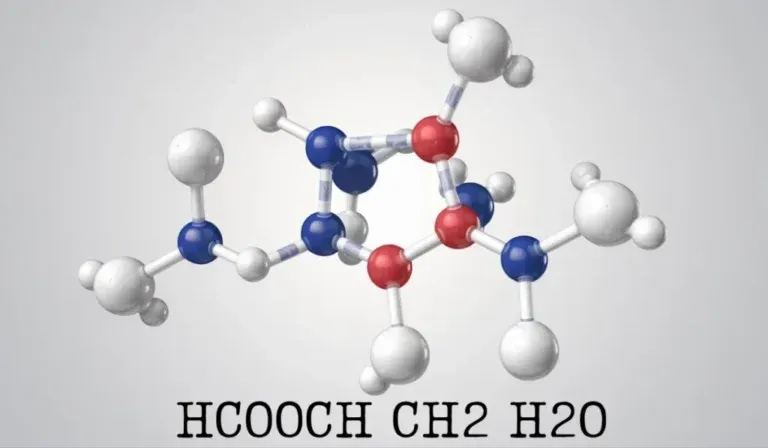Introduction
Have you ever come across the chemical term HCOOCH CH2 H2O and wondered what it means or how it plays a role in modern science? Understanding the components of this intriguing combination can unlock a variety of uses in both industrial and laboratory settings. HCOOCH CH2 H2O, which represents a mixture of formic acid (HCOOH), methylene (CH₂), and water (H₂O), is vital for many processes, including energy solutions and polymer synthesis. Whether you are a chemistry enthusiast or a researcher, this article will explore its molecular structure, reactivity, industrial uses, and safety considerations. By the end, you’ll have a clear understanding of how this unique chemical combination powers innovations across various fields.
What Is HCOOCH CH2 H2O?
Let’s break down the chemistry behind HCOOCH CH2 H2O and its components:
- Formic Acid (HCOOH): A simple but highly reactive carboxylic acid. It is often used as a reducing agent and a catalyst in chemical reactions.
- Methylene (CH₂): A highly reactive molecule that serves as a bridge between other compounds, often used in organic syntheses and polymerization processes.
- Water (H₂O): The solvent that stabilizes reactions, facilitates proton transfer, and aids in the hydration of molecules.
Together, these components form a dynamic trio that can facilitate a range of chemical reactions. In HCOOCH CH2 H2O, formic acid donates protons, methylene links molecules, and water serves as a stabilizing medium.
How Does HCOOCH CH2 H2O Work in Chemical Reactions?
In solution, these chemicals interact in unique ways to produce useful compounds. For example:
- Hydration and Dehydration: Water can add to or remove from methylene compounds, making it a key player in controlling reaction rates.
- Redox Reactions: Formic acid often donates hydrogen, reducing metal catalysts or organic molecules.
- Polymer Synthesis: Methylene can link with other organic molecules, forming polymers that are used in materials like plastics and resins.
These processes make HCOOCH CH2 H2O highly valuable in industries where precise chemical control is needed.
Industrial Applications of HCOOCH CH2 H2O
From manufacturing to energy, HCOOCH CH2 H2O has a variety of industrial applications:
Textile Processing
Formic acid-water mixtures are used in textile dyeing. The CH₂ links improve the fastness of colors, making the dyeing process more efficient and durable. This application is particularly relevant in the textile industry, where long-lasting colors are essential.
Rubber Production
In rubber manufacturing, HCOOCH CH2 H2O is used to coagulate latex. The methylene derivatives help control the cross-linking of polymers, improving the rubber’s elasticity. This leads to better performance in products like tires and medical gloves.
Formic Acid Fuel Cells
In the renewable energy sector, HCOOCH CH2 H2O is integral to the development of formic acid fuel cells. Formic acid serves as a safe hydrogen reservoir, releasing protons and electrons when needed. This creates a sustainable energy solution that’s being explored for use in clean energy systems.
These applications demonstrate how HCOOCH CH2 H2O is pivotal in producing materials that drive industries forward.
Laboratory Applications and Safety Considerations
Practical Uses in the Lab
In laboratories, HCOOCH CH2 H2O is a versatile chemical mixture used in various experimental procedures. Here are a few examples:
- Polymer Synthesis: Scientists use CH₂-based monomers in formic acid solutions to create polymers with specific properties. This is essential for producing resins and other materials used in manufacturing.
- Catalyst Testing: HCOOCH CH2 H2O is also used in reactions involving metal catalysts, such as palladium or copper, to test hydrogenation and coupling reactions.
Safety Precautions
While HCOOCH CH2 H2O is useful, it’s crucial to handle it with care:
- Corrosive Nature: Formic acid can irritate skin and damage metals. Always use gloves, goggles, and protective clothing.
- Volatility: Methylene compounds can vaporize, so work in well-ventilated areas or under fume hoods to avoid inhalation.
By adhering to safety protocols, you can safely use HCOOCH CH2 H2O in both industrial and research settings.
Conclusion
In conclusion, HCOOCH CH2 H2O is a powerful chemical combination that plays a vital role in various industries, including energy production, polymer science, and textiles. Understanding its molecular composition, reactivity, and safety considerations can help harness its full potential. As research continues, this chemical trio is likely to fuel even more innovations, from sustainable manufacturing processes to clean energy solutions.
Have you worked with HCOOCH CH2 H2O in any of your projects? Share your experiences in the comments below, and be sure to check out our other articles on cutting-edge chemical technologies!

